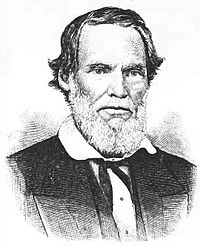Baylor University athletic teams, known as the Bears, participate in 19 intercollegiate sports. The university is a member of the Big 12 Conference for all NCAA Division I athletics.
History
This statue of Judge Baylor is at the front of Founder's Mall in the heart of campus
Judge R. E. B. Baylor
During the 1846 school year Baylor leaders would begin including chapel as part of the Baylor educational experience. The tradition continues today and has been a part of the life of students for over 160 years. In 1849, R.E.B. Baylor and Abner S. Lipscomb of the Texas Supreme Court began teaching classes in the "science of law," making Baylor the first in Texas and the second university west of the Mississippi to teach law. During this time Stephen Decatur Rowe would earn the first degree awarded by Baylor. He would be followed by the first female graduate, Mary Kavanaugh Gentry, in 1855.
In 1851, Baylor's second president Rufus Columbus Burleson decided to separate the students by sex, making the Baylor Female College an independent and separate institution. Baylor University became an all-male institution. During this time, Baylor thrived as the only university west of the Mississippi offering instruction in law, mathematics, and medicine. At the time a Baylor education cost around $8–$15 per term for tuition. And many of the early leaders of the Republic of Texas, such as Sam Houston, would later send their children to Baylor to be educated. Some of those early students were Temple Lea Houston, son of President Sam Houston, a famous western gun-fighter and attorney; and Lawrence Sullivan "Sul" Ross famous Confederate General and later President of Texas A&M University.
In 1892, Baylor University had two main buildings, Old Main and Burleson Hall
Beginning in 1885, Baylor University moved to Waco, Texas, a growing town on the railroad line. It merged with a local college called Waco University. At the time, Rufus Burleson, Baylor's second president, was serving as the local college's president. That same year, the Baylor Female College also was moved to a new location, Belton, Texas. It later became known as the University of Mary Hardin-Baylor. A Baylor College Park still exists in Independence in memory of the college's history there. Around 1887, Baylor University began readmitting women and became coeducational again.
In 1900, three physicians founded the University of Dallas Medical Department in Dallas, although a university by that name did not exist. In 1903, Baylor University acquired the medical school, which became known as the Baylor College of Medicine, while remaining in Dallas. In 1943, Dallas civic leaders offered to build larger facilities for the university in a new medical center if the College of Medicine would surrender its denominational alliances with the Baptist state convention. The Baylor administration refused the offer and, with funding from the M. D. Anderson Foundation and others, moved the College of Medicine to Houston. In 1969, the Baylor College of Medicine became technically independent from Baylor University. The two institutions still maintain strong links and Baylor still elects around 25 percent of the medical school's regents. They also share academic links and combine in research efforts.
During World War II, Baylor was one of 131 colleges and universities nationally that took part in the V-12 Navy College Training Program which offered students a path to a Navy commission.




कोई टिप्पणी नहीं:
एक टिप्पणी भेजें